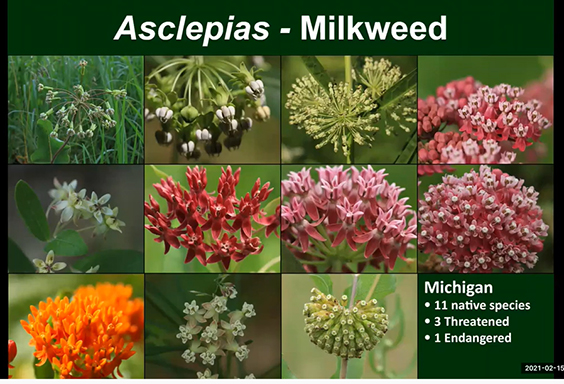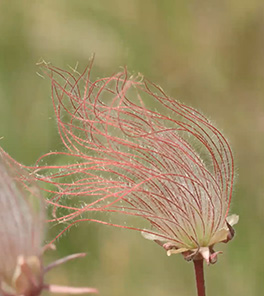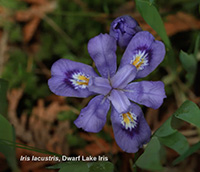
FEBRUARY PROGRAM RECAP
by Rebecca Marquardt, Programs Committee Member
Botanical Quest: Documenting Michigan’s Rare Native Flora Through Photography
Presented by Craig Elston 2/15/2021
Craig Elston has been an inquisitive naturalist his whole life, as is often the case with those who leave a legacy in natural history. Craig’s gift to the world is botanical photography and an in-depth understanding of his subject matter.
As with famous conservationist Aldo Leopold and Grand Rapids’ own best known landscape architect O.C. Simonds, the foundation of their interest in natural plant and animal communities began during childhood and the places they made their very first observations: their backyards, neighborhoods, and property associated with their families. For Craig, it was his grandparents’ farm. Thanks to a camera that he got when he was just 10 years old, he could capture the profound observations he made of the natural world. What began as an interest in butterflies led him to plants, as he noticed what leaves the caterpillars ate and flowers the butterflies visited.
Craig acknowledged the community of botanists he has learned from as well as the opportunities he has been given to steward the land and educate others in his West Michigan community. The stunning photographs he shared throughout the presentation depicted his initiative and drive to contribute to the protection of natural plant communities. Though he took us all around the state of Michigan, the 75 acre Hudsonville Nature Preserve that he manages as Naturalist for the City of Hudsonville, alone, has over 300 species of plants.

We learned about the Michigan Botanic Club(MBC) and the forays they take to natural areas to share collectively in the joy and wonder of seeing native plants in their natural habitat. Many of the species Craig shared with us are considered rare, and as any good educator, he defined the degrees of rarity as: Endangered, Threatened, or Special Concern. With each of the plant species he featured, he explained which of the three it was. He also explained some of the ethics and laws associated with rare plants, such as it is illegal to collect seed from plants that are considered Endangered or Threatened without a permit. An example scenario he shared with us was that the DNR granted special permission for the MBC to rescue plants ahead of scheduled development of a site. As a result of this mitigation effort, Craig was able to save some State Threatened Prairie Smoke, Geum triflorum from being destroyed.
He encouraged the audience to visit the Michigan Natural Features Inventory’s website, to learn more about the unique plant communities found in Michigan, as well as the status of a given plant species (example: Geum triflorum), or to find the book that was published based on the material that can be found there (see References*). He shared photographs of plants found in bogs, cedar swamps, dry oak-barrens, oak-hickory forests, mixed conifer forests, sand dunes and cobble shorelines, on steep slopes, and within floodplains. He gave us a tour around the entire state to attest to the degree of commitment, enthusiasm, and passion he has for Michigan’s native plants.
Craig carefully described how each of the species he chose to present to us has a story and is unique, not only ecologically, but also geographically and from an historical perspective. We learned that some of the plants he showed are endemic, or only found, in Michigan or the Great Lakes region. The yellow, mat forming Michigan Monkey Flower is endemic to only Michigan and one place we might be able to see it is in a park on Glen Lake, or along the shoreline of Lake Michigan. In some cases, he shared when the plant was first observed here, like the Pitcher’s Thistle. Another endemic species to the sand dunes of Lakes Michigan, Huron and Superior, Cirsium pitcheriis named in honor of Army Surgeon Zina Pitcher, who recorded seeing the plant in 1826 on the sand dunes of Lake Superior. Craig described some of the commonly found species that botanist and teacher Emma Cole recorded in her 1901 publication on the flora of Grand Rapids, some of which can no longer can be found today. Fortunately, there are fellow botanists dedicated to study this further, as Garrett Crow and Dave Warners are continuing to do at Calvin University.

Botany is a science, and the study of native plants from a scientific perspective is vastly different from gardening with native plants. The University of Michigan Botany Department is one of the finest in the country and has produced some of the most reputable botanists the world has ever known. Craig regularly engages with and contributes to that community as President of the White Pine Chapter of the Michigan Botanical Club. Whether discussing the morphology of the plant structure, reason why species grow in specific areas, or infusing his affectionate descriptions of a “cheery little” Dwarf Lake Iris, his delivery was magnificent.
Craig is an excellent naturalist, as he could be considered an interpreter of natural history and an instructor in the art of observation. Through fascinating details and stories about the plants he chose to share with us, Craig Elston educated, entertained and captivated us in an approachable way. He encourages us to get out there and experience the natural world and extended an open invitation for us to learn more from him, whether in the techniques of photography or watching the Spring ephemerals emerge in a couple of months. His collection of native plant photos, which can be found on his website is a masterpiece and legacy in the making.
*View/download a list of Program References.
Click below to view Craig Elston’s presentation.
[youtube https://www.youtube.com/watch?v=RGxafAxmJFc&w=560&h=315]
